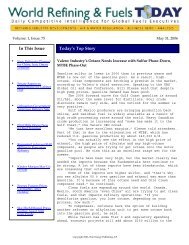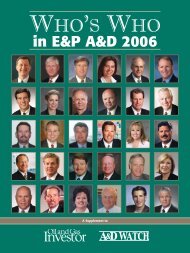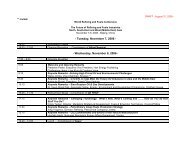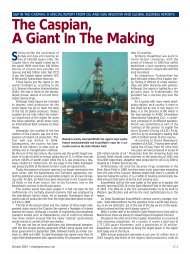ASTM: Gasoline Today and Tomorrow – An Executive Report
ASTM: Gasoline Today and Tomorrow – An Executive Report
ASTM: Gasoline Today and Tomorrow – An Executive Report
You also want an ePaper? Increase the reach of your titles
YUMPU automatically turns print PDFs into web optimized ePapers that Google loves.
Octane Week | <strong>ASTM</strong>: <strong>Gasoline</strong> <strong>Today</strong> <strong>and</strong> <strong>Tomorrow</strong> - <strong>An</strong> <strong>Executive</strong> <strong>Report</strong><br />
(from p16)<br />
of an offset,” he told <strong>ASTM</strong> members<br />
meeting in Pittsburgh. “The DI change addresses a<br />
technical issue that arose out of CRC studies. The<br />
secondary aspect, to have it apply at retail, grew out of<br />
state positions in the past.”<br />
The most recent CRC study, completed in 2004,<br />
was “probably the best cold-start driveability program<br />
run,” said Task Group member Lew Gibbs of Chevron.<br />
Vehicles were screened for responsiveness, raters were<br />
trained <strong>and</strong> calibrated <strong>and</strong> procedural changes were<br />
made to the program. “The result showed a high degree<br />
of statistical correlation between driveability <strong>and</strong> an<br />
adjusted DI index.”<br />
In contrast, previous CRC tests included older cars<br />
<strong>and</strong> a larger ethanol offset, Gibbs explained. “The latest<br />
test had the best representation of modern vehicles<br />
on the road,” he told Octane Week. After meeting in<br />
Naperville, Ill., to discuss the results, Task Group<br />
members determined to propose balloting a DI change<br />
to the entire group.<br />
Specific Proposal Language<br />
The proposal to be balloted was as follows:<br />
Change Table 1, footnote C, to read<br />
“Driveability Index (DI) = 1.5 T10 + 3.0 T50 +<br />
1.0 T90 + 1.33 o C (2.4 o F) * Ethanol Volume%<br />
where T10 = distillation temperature, o C<br />
( o F) at 10% evaporated, T50 = distillation<br />
temperature, o C ( o F) at 50% evaporated, <strong>and</strong><br />
T90 = distillation temperature, o C ( o F) at 90%<br />
evaporated.”<br />
Change footnote D with the following:<br />
“During spring <strong>and</strong> fall transitions into <strong>and</strong><br />
out of the federal vapor pressure control<br />
period, the Driveability Index requirement<br />
of the volatility class specified in Table 4 is<br />
waived so long as the DI meets that of the<br />
volatility class corresponding to the measured<br />
vapor pressure of the retail sample.”<br />
Refiners might have to tighten the base fuel<br />
properties in order to accommodate DI with an ethanol<br />
offset. A 2.4ºF *10 vol% translates to a 24-point more<br />
stringent spec.<br />
Task Group members expressed concern about the<br />
impact on conventional gasoline. At that time, refiners<br />
did not know whether ethanol would be added to CG<br />
downstream of the refinery, which would create a noncomplying<br />
blend.<br />
But as Gibbs pointed out, when ethanol is added at<br />
10 vol%, it lowers the 10% <strong>and</strong> 50% evaporated points,<br />
which in turn, lowers DI about 60 points, on average.<br />
The ethanol adjustment for 10 vol% is only about 24<br />
points. Since the upward adjustment is smaller than the<br />
downward blending effect, the blends will always be in<br />
compliance, he said.<br />
A 24-point more stringent spec will mean<br />
additional manufacturing costs for refiners, one fuels<br />
industry representative said. “This is going to cost more<br />
to produce,” said Bob Schaefer of BP.<br />
The DI change is coming at a time when refineries<br />
are running at maximum, Schaefer pointed out. In the<br />
future, refiners will have to make additional amounts<br />
of low-Rvp fuels due to the implementation of the U.S.<br />
EPAʼs 8-hour ozone st<strong>and</strong>ard. That will probably lead<br />
to fuel quality changes. “States will need emissions<br />
reductions, <strong>and</strong> fuels will be on the list.”<br />
Schaefer observed that the latest CRC study utilized<br />
a fuel set of 10 fuels, eight of which had a DI in excess<br />
of the current <strong>ASTM</strong> maximum of 1250. “The majority<br />
of the fuel set contains fuels that are non-compliant,”<br />
he noted.<br />
A correlation was developed between the effect<br />
observed on high-DI fuels <strong>and</strong> applied to the on-spec<br />
fuels.<br />
CRCʼs research was “good science” Schaefer said,<br />
“but the application of the correlation would not be<br />
good science.”<br />
Testing a broad range of fuels is common at CRC.<br />
Two of the test fuels had DIs below the 1250 maximum<br />
<strong>and</strong> four were around 1265, Chevronʼs Gibbs countered.<br />
Previous tests included fuels with DI as low as 1160,<br />
<strong>and</strong> they showed an offset for ethanol was needed. “We<br />
exp<strong>and</strong>ed the envelope to get a scale so you can see<br />
an effect. Thatʼs common practice <strong>and</strong> accepted good<br />
science.<br />
“The relationship between the adjusted DI <strong>and</strong><br />
driveability demerits was linear on a log basis, indicating<br />
applicability at lower DI levels,” Gibbs said. “Members<br />
of the auto, oil <strong>and</strong> ethanol industry all agree that this<br />
offset has applicability.” (continued on p18)<br />
February 2007 17
















